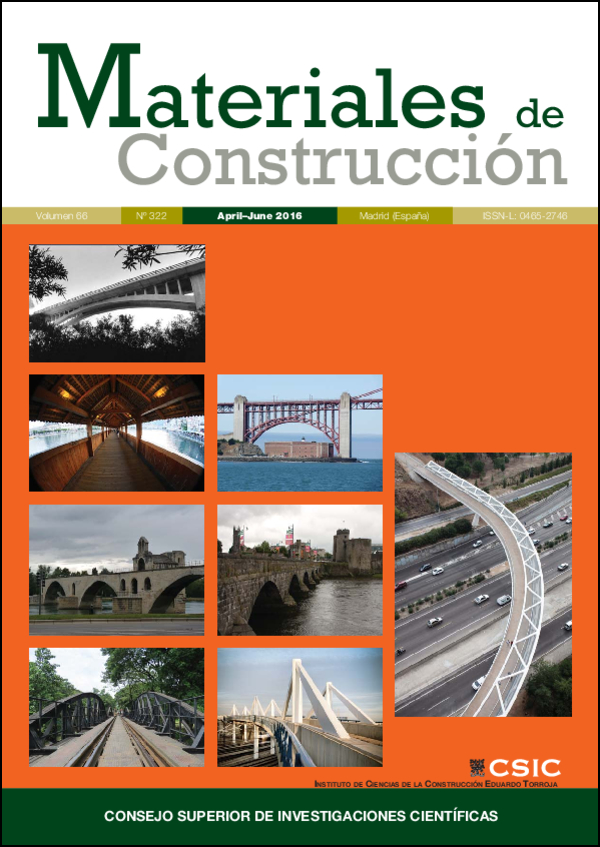Effect of pozzolans with different physical and chemical characteristics on concrete properties
DOI:
https://doi.org/10.3989/mc.2016.01815Keywords:
Concrete, Metakaolin, Pozzolans, Durability, Physical propertiesAbstract
The durability of concrete structures is an important issue nowadays. Specifically in the case of reinforced concrete bridges or other infrastructures one of the main form of environmental attack is the penetration of chloride ions, which leads to corrosion of concrete steel reinforcement. This study aims to evaluate the effect of the introduction of metakaolin and diatomite, two chemically and physically different pozzolans, on the resistance of concrete to the penetration of chlorides but also the effect on other properties of concrete, namely, its compressive strength and its porosity distribution. The results of this study show that the pozzolans physical and chemical characteristics have a strong influence on the pozzolans behavior and, consequently, on the concrete properties.
Downloads
References
1. Glasser, F.P.; Marchand, J.; Samson, E. (2008) Durability of concrete - Degradation phenomena involving detrimental chemical reactions. Cem. Con. Res., 38, 226–246. http://dx.doi.org/10.1016/j.cemconres.2007.09.015
2. Hong-Sam, Kim; Sang-Ho; Han-Young Moon. (2007) Strenght properties and durability aspects of high strength concrete using Corean metakaolin. Cons. Build. Mat., 21, 1229–1237. http://dx.doi.org/10.1016/j.conbuildmat.2006.05.007
3. Siddique, R.; Klaus, J. (2009) Influence of metakaolin on the properties of mortar and concrete a review. Appl. Clay. Sci., 43, 392–400. http://dx.doi.org/10.1016/j.clay.2008.11.007
4. Sang-Soon Park; Seung-Jun Kwon; Sang Hwa Jung. (2012) Analysis technique for chloride penetration in cracked concrete using equivalent diffusion and permeation. Con. Build. Mat., 29, 183–192. http://dx.doi.org/10.1016/j.conbuildmat.2011.09.019
5. Ding-yi Yang; Jing-jing Luo. (2012) The damage of concrete under flexural loading and saline solution. Con. Build. Mat., 36, 129–134. http://dx.doi.org/10.1016/j.conbuildmat.2012.05.019
6. Khatib, J.M.; Clay, R.M. (2004) Absorption characteristics of metakaolin concrete. Cem. Con. Res., 34, 19–29. http://dx.doi.org/10.1016/S0008-8846(03)00188-1
7. Jones, TR. (2003) Metakaolin as pozzolanic addition to concrete. In: Barnes P, Bensted J, editors. Structure and performance of cements. England: Spon Press.
8. Hubertova, M.; Hela, R. (2007) The effect of metakaolin and silica fume on the properties of lightweight self-consolidating concrete. ACI Publication SP-243-3. Detroit: American Concrete Institute, 35–48.
9. Hassan, A.A.A; Lachemi, M; Hossain, K.M.A. (2012) Effect of metakaolin and silica fume on the durability of self-consolidating concrete. Cem. Con. Comp., 34, 801–807. http://dx.doi.org/10.1016/j.cemconcomp.2012.02.013
10. Bai J.; Wild S.; Sabir B.B. (2003) Chloride ingress and strength loss in concrete with different PC–PFA–MK binder compositions exposed to synthetic seawater. Cem. Conc. Res., 33, 353–362. http://dx.doi.org/10.1016/S0008-8846(02)00961-4
11. Martin-Pérez, B.; Zibara, H.; Hooton, R.D.; Thomas, M.D.A. (2000) A study of the effect of chloride binding on service life predictions. Cem. Conc. Res., 30, 1215–1223. http://dx.doi.org/10.1016/S0008-8846(00)00339-2
12. Linhua Jiang; Guohong huang; Jinxia X; Yeran Zhu; Lili Moa. (2012) Influence of chloride salt type on threshold level of reinforcement corrosion in simulated concrete pore solutions. Con. Build. Mat., 30, 516–521. http://dx.doi.org/10.1016/j.conbuildmat.2011.12.044
13. Zhiguang Shi; Zhonghe Shui; Qiu Li; Haining Geng. (2015) Combined effect of metakaolin and sea water on performance and microstructures of concrete. Con. Build. Mat., 74, 57–64. http://dx.doi.org/10.1016/j.conbuildmat.2014.10.023
14. Degirmenci, N.; Yilmaz, A. (2009) Use of diatomite as partial replacement for Portland cement in cement mortars. Con. Build. Mat., 23, 284–288. http://dx.doi.org/10.1016/j.conbuildmat.2007.12.008
15. Rahhal, V.; Talero, R. (2009) Calorimetry of Portland cement with silica fume, diatomite and quartz additions. Con. Build. Mat., 23, 3367–3374. http://dx.doi.org/10.1016/j.conbuildmat.2009.06.003
16. Aydin, A.C.; Gul, R. (2007) Influence of volcanic originated natural materials as additive on the setting time and some mechanical properties of concrete. Con. Build. Mat., 21, 1277–1281. http://dx.doi.org/10.1016/j.conbuildmat.2006.02.011
17. Yilmaz, B.; Ediz, N. (2008) The use of raw and calcined diatomite in cement production. Cem. Con. Comp., 30, 202–211. http://dx.doi.org/10.1016/j.cemconcomp.2007.08.003
18. Stamatakis, M.G; Csirik, G.; Bedelean, I.; Pedersen, S. (2003) The influence of biogenic-silica-rich rocks on the properties of blended cements. Cem. Con. Comp., 25, 177–184. http://dx.doi.org/10.1016/S0958-9465(02)00019-7
19. Young, J.F.; Mindess, S.; Gray, R.J.; Bentur, A. (1998) The Science and Technology of Civil Engineering Materials, Ed. Prentice Hall Inc., New Jersey.
20. Hewlett, P.C. (2001) Lea's Chemistry of Cement and Concrete, Ed. Butterworth-Heinemann, Oxford.
21. Rixom, R.; Mailvaganam, N. (1999) Chemical Admixtures for Concrete, Ed. E & FN Spon, London.
22. Wild, S.; Khatib, J.M.; Jones, A. (1996) Relative strength, pozzolanic activity and cement hydration in superplasticized metakaolin concrete. Cem. Con. Res., 26, 1537–1544. http://dx.doi.org/10.1016/0008-8846(96)00148-2
23. Michael, D.A.; Thomas, Phil.; Bamford, B., (1999) Modelling chloride diffusion in concrete: Effect of fly ash and slag. Cem. Con. Res., 29, 487–495. http://dx.doi.org/10.1016/S0008-8846(98)00192-6
Published
How to Cite
Issue
Section
License
Copyright (c) 2016 Consejo Superior de Investigaciones Científicas (CSIC)

This work is licensed under a Creative Commons Attribution 4.0 International License.
© CSIC. Manuscripts published in both the print and online versions of this journal are the property of the Consejo Superior de Investigaciones Científicas, and quoting this source is a requirement for any partial or full reproduction.
All contents of this electronic edition, except where otherwise noted, are distributed under a Creative Commons Attribution 4.0 International (CC BY 4.0) licence. You may read the basic information and the legal text of the licence. The indication of the CC BY 4.0 licence must be expressly stated in this way when necessary.
Self-archiving in repositories, personal webpages or similar, of any version other than the final version of the work produced by the publisher, is not allowed.
















